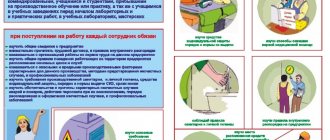Who develops the training program
At the enterprise, the occupational safety training program is developed by heads of structural units with the support of occupational safety specialists. Then the document is approved by the head of the organization after agreement with the trade union (if there is one): a special order is issued or a record of approval is made in the program itself.
Training organizations develop and approve training programs independently and, as a rule, coordinate them with the relevant federal or regional executive authorities in the field of labor protection.
Where can I get an occupational safety training program?
Perhaps the best starting point for drawing up a document would be an approximate training program on labor protection , approved by the Ministry of Labor on May 17, 2004, or more suitable for the purposes of the training (or rather, the categories of students). Thus, by order of the Ministry of Labor and Social Development of the Russian Federation dated June 21, 2003 N153, exemplary labor protection training programs were approved for:
- specialists and heads of labor protection services of organizations;
- members of committees (commissions) on labor protection of organizations;
- authorized (trusted) persons for labor protection of trade unions;
- heads of budgetary institutions.
After choosing the most suitable occupational safety training program, the next task is to adapt the program to the specifics of the organization; asserting it in its original, typical form is a fairly common mistake. Before introducing a standard program, you should review it for the following nuances:
- Has the organization created a labor protection service, or is there only a labor protection specialist on the staff list (or is there less than 50 employees in the organization)?;
- Is there provision for the provision of milk (other preventive nutrition), personal protective equipment (PPE) and provision of benefits?
- Is production organized in the organization, are minors employed, are workers in certain professions subject to medical examinations?
Confused? Sign up for an express occupational safety audit!
Taking into account the above points, the occupational safety training program becomes adapted to the specifics of a particular organization. To fully “customize” the program, all that remains is to provide each of the points with brief, abstract comments - what will be discussed in each section of the program.
What to take as a basis
When preparing your own training program, you must use sample curricula and programs approved by the Ministry of Labor:
- Approximate health training program for employees of organizations, approved by the Ministry of Labor on May 17, 2004;
- Sample training plans for occupational safety and testing knowledge of occupational safety requirements for employees of organizations, approved by the Ministry of Labor on May 17, 2004;
- Sample training programs in occupational safety for certain categories of insured persons, approved by Order of the Ministry of Labor dated June 21, 2003 No. 153;
- Standard training program in occupational safety (for enterprise managers and members of knowledge testing commissions), approved by the Ministry of Labor on May 12, 1996.
These documents must be supplemented with missing sections and training materials relevant to the specific position, and inappropriate information must be corrected or deleted.
You can also resort to rules and standard instructions on labor protection and other regulations in this area.
In addition to the program, you need to prepare a thematic training plan for occupational safety (a document listing the topics studied and indicating the number of hours for each of them) and exam papers to test the knowledge of workers. Tickets must contain only the information included in the training.
TRAINING PROGRAM on safe methods and techniques for performing the work of an instrumentation mechanic
This program is compiled on the basis of GOST 12.0.004-90 and Resolution of the Ministry of Labor of the Russian Federation, Ministry of Education of the Russian Federation dated January 13, 2003 No. 1/29, taking into account the Letter of the Ministry of Labor of Russia dated May 17, 2004.
The basis for training and subsequent testing of knowledge of workers in blue-collar professions are instructions on labor protection and fire safety.
- The concepts of “occupational safety” and “fire safety”.
- The employee’s responsibility to comply with labor protection requirements, fire safety and labor regulations.
- The main causes of injuries for this profession.
- Basic safety requirements for IOT for an instrumentation mechanic of category 6.
- Safety requirements for electrical personnel repairing switchgear.
- Safety requirements for electrical personnel servicing electrical equipment of basalt-plastic reinforcement production lines.
- Safety requirements for electrical personnel when working on ladders and stepladders.
- Safety requirements for electrical personnel servicing electrical equipment of lines for applying sand anchors to basalt-plastic reinforcement.
- Safety requirements for electrical personnel servicing electrical equipment of lifting machines.
- Safety requirements when working at height.
- Safety requirements for electrical personnel when working with a megger.
- Safety requirements when working with hand tools.
- Safety requirements when moving on foot around the territory and production premises.
- Safety requirements when performing loading, unloading and warehouse operations.
- Electrical safety requirements.
- Fire safety basics.
- Actions of an employee in case of an accident, fire and (or) emergency.
- Providing first aid to victims.
Well, how do you like this minimum of knowledge for a worker, huh? Almost everything in it is from labor safety instructions for workers in this profession. Nothing extra!
This is a version of the program; in its likeness, following the instructions, you can create any program. You can also make notes for the program, but I think
I don’t know about you, but I, if the GIT presents me with something on training and testing the knowledge of workers, I’ll give him this article to read.
Be minimalists, do not inflate labor safety documentation to unrealistic proportions, give the employee only what he needs.







